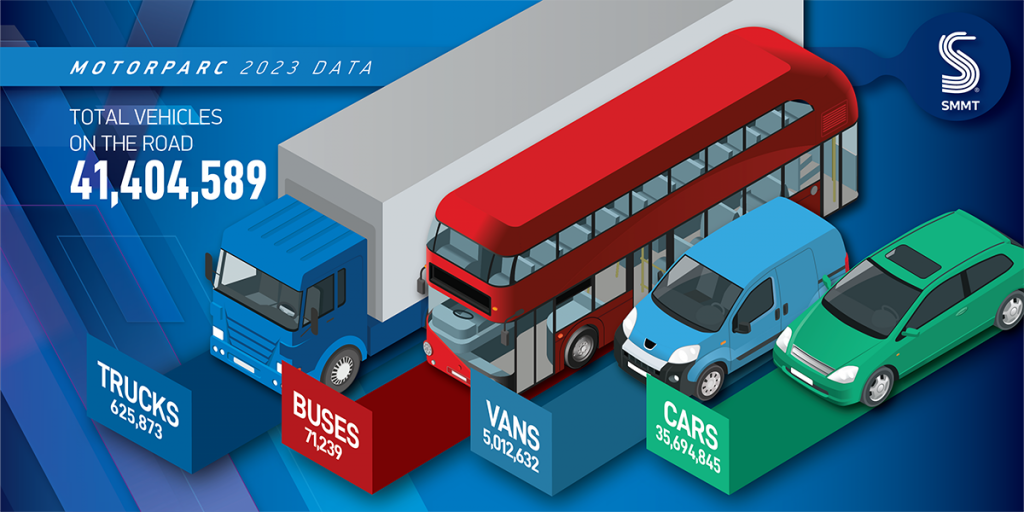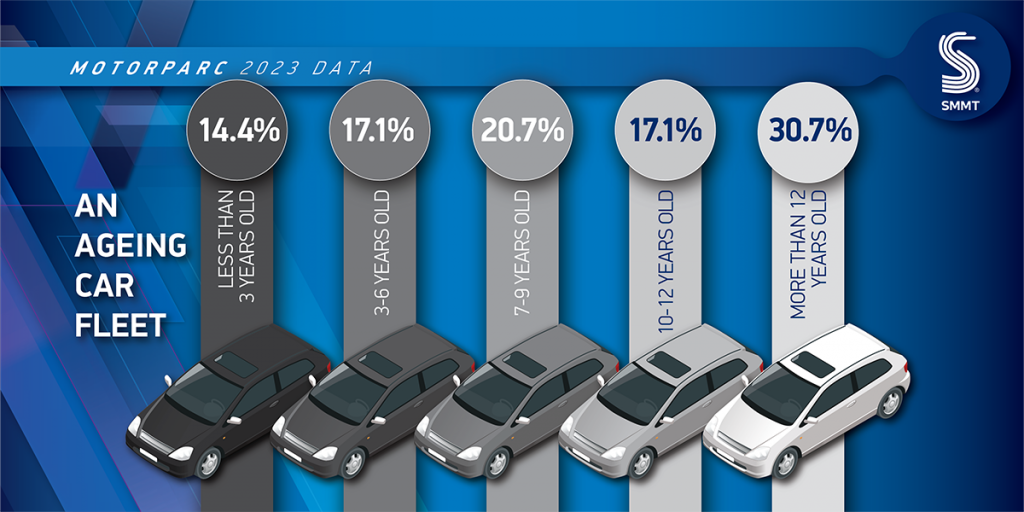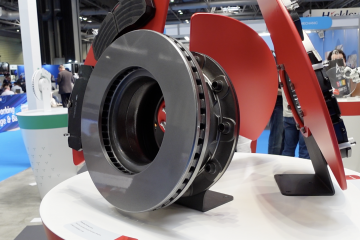The number of vehicles on UK roads reached record levels in 2023, as the average age of passenger cars rose again, and scrappage levels decreased, indicating drivers are keeping their cars for longer.
The latest UK car parc figures, released by the Society of Motor Manufacturers and Traders (SMMT) show that by the end of 2023, there were 35,694,845 passenger cars on the country’s roads, up by 1.6% year on year.
This growth was driven by electric vehicles (EVs), made up of battery-electric vehicles (BEVs) and plug-in hybrids (PHEVs). Almost half a million of these models were registered last year, the biggest increase the market has seen. The number of BEVs in use increased by 47.3% compared with 2022, meaning these zero-emission vehicles now account for 2.7% of all cars in use, up from just 1.9% in 2022.

“After two challenging years of constrained supply, more people and businesses across the UK are now getting back behind the wheel, and increasingly, opting for greener options,” commented SMMT chief executive Mike Hawes.
“However, given the ageing fleet, we now need to encourage consumers and businesses who have deferred purchases of new cars, vans, trucks and buses to upgrade. A stronger and stable economy, coupled with reduced living costs, would boost consumer and business confidence, while compelling fiscal incentives would ensure that these purchases are emissions free. Not only would this accelerate the transition, fundamental to the UK’s net-zero ambitions, but it would also stimulate the economy and enhance the wider environment in which we all live.”
Average UK car parc age gets older
The SMMT figures show that the average UK car parc age has increased again, and now sits at nine-years-old. This has grown by more than a year since 2019, highlighting that through the COVID-19 pandemic and beyond, drivers are keeping their vehicles for longer.
This corresponds with the drop in new-car registrations since 2020. While overall numbers finally improved year-on-year in 2023, with the pandemic and following supply-chain crisis impacting the market, they were still some way down on 2019 figures, when over 2.3 million models were delivered.
Registration numbers have not peaked at over two million since then, while the high of almost 2.7 million registration sin 2016 seems some way away. With the slower UK car parc growth, it is clear that older models are remaining on the road.

Alongside this, scrappage rates of older vehicles has also fallen to the lowest on record, according to the SMMT. This means that while 14.4% of cars in the UK car parc are less than three years old, 47.8% are over 10 years of age, with the biggest share, 30.7% of cars, being made up of models over 12-years-old.
As 20.7% of passenger cars are between seven and nine-years-old, the number of models in the UK car parc registered after 2014 stands at around 24.5 million. As older cars are more likely to frequent the independent garage market, this offers an increased opportunity for the sector. The older the car, the more likelihood it will need servicing or repair.
“Given the current average age of cars in the UK now standing at nine years and lower scrappage rates, it is clear that drivers are opting to hold onto their vehicles for longer periods,” commented IGA Chief Executive Stuart James. “This dynamic presents a significant opportunity for the Independent Garage Sector to thrive.
“Independent Garages already manage over 70% of all vehicle service and maintenance in the UK. Amidst economic hardship and the prevailing cost-of-living crisis, customers prioritise quality service and value for money, a strength that independent garages consistently offer.”
Discontinued models still popular
There is another reason for the increased age of the UK car parc. Popular models are being discontinued by manufacturers in favour of bigger SUVs or electric variants. The most popular car in the UK last year remained the Ford Fiesta, with almost 1.5 million on the road.
This is despite the small car being discontinued by Ford at the end of 2022. Buyers wanting a Fiesta will turn to the used-car market, keeping these models on the road for years to come. The same can be said of the Ford Focus, with 1.05 million units still available in the UK car parc at the end of 2023.
In fact, the supermini market saw just over 11.8 million units within the UK car parc, while SUVs made up just 5.7 million. Carmakers may be phasing out smaller models, but they are popular amongst drivers, meaning they will likely be a big part of the older parc age for years to come.
EVs driving UK car parc growth
Despite a record number of vehicles on UK roads, the average car in use saw CO2 emissions drop by 2.1% last year. This is thanks to the increased number of BEVs and PHEVs taking to the country’s roads.
The SMMT’s UK car parc figures show that at the end of 2023, over 950,000 passenger cars featured and all-electric drive. Since then, the country has surpassed one million BEV registrations, showing growth in the sector.

EVs made up 4.3% of cars in the UK last year, with PHEVs taking a 1.6% share, and BEVs 2.7%. This is up from the 1.9% recorded at the end of 2022. While BEV registrations stumbled at the end of the year, this was likely due to a need by manufacturers to hold back deliveries to aid their ability to meet ZEV Mandate targets.
For 2024, a total of 22% of all a manufacturer’s passenger car sales must come from zero-emission vehicles (ZEVs). Therefore, many carmakers will have waited to deliver cars set for the end of the year into 2024, adding to their annual total. The market has continued to grow so far in 2024.
However, while overall EV use in the UK car parc figures continues to grow, The SMMT has highlighted that public chargepoint rollout is still lagging. There is still just one standard public charger available for every 35 plug-in cars on the road, only a slight improvement from one for every 36 last year.
While EVs increased their market share, the UK car parc was still dominated by petrol models, with 58.3% of cars on the road powered by the fuel. Interesting, despite their decline in recent yearly registrations, diesels still made up 34% of the parc.
This again suggests drivers are holding on to their diesel models, providing another opportunity for the independent aftermarket, to service and maintain these cars. Diesel skills will still be required for many years to come.
Interesting points
- The highest number of cars in the UK car parc reside in London and the South East (8,910,951), followed by the North West (3,959,236) and the South West (3,572,387)
- With electric vehicles increasing in popularity, manual transmissions have fallen to 63.5% of the parc, down from 66.0% in 2022.
- London and the South East is also the region with the highest volume of plug-in vehicles, with over half a million (527,887) of these green vehicles making up 5.9% of all cars in the area
- The UK might be the fifth rainiest country in Europe, yet that has not stopped convertibles accounting for almost one in 35 cars on the road, with 1,022,849 in use – falling very slightly on 2022 by 0.1 percentage points7
- Continuing their domination, superminis remain the most popular car type on roads, with one in three drivers choosing these more compact vehicles to get around
- You are more likely to see a car or van painted white than in any other colour in the UK, with 8,187,012 of them on the roads. Black and grey come in second and third place at 7,609,015 and 6,792,003 units respectively
- Almost 25,000 pink cars can be found on British roads – with four in five registered to women. Wales has the highest proportion of pink cars, accounting for 0.1% of those in use. Scotland has the highest proportion of red cars at 12.3%




You must be logged in to post a comment.